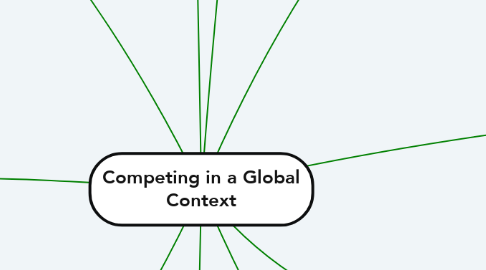
1. Finance
1.1. IMF
1.2. Exchange Rates
1.2.1. 'Forex'
1.2.1.1. Supply
1.2.1.2. McBurger Index
1.2.1.3. Impact
1.2.1.3.1. Price
1.2.1.3.2. Availablity
1.2.1.3.3. Exports
1.2.1.3.4. Imports
1.2.1.3.5. SME's
1.2.1.3.6. Competition
1.3. Multinationals
1.3.1. Investments
1.4. Imbalances
1.4.1. Crisis (GFC)
1.5. Paymants
1.5.1. Accounts
1.5.1.1. Current
1.5.1.2. Capital
1.5.1.3. Financial
1.6. Tax
1.6.1. International Rates
1.6.1.1. Rules
1.6.1.2. Transfer
1.6.1.2.1. Pricing
1.6.1.2.2. Mispricing
1.7. Reporting
1.7.1. Borrowed
1.7.2. Imperialism
1.7.3. Contingent Model
1.7.4. Taxation
1.7.5. Regulation
1.7.6. IFRS
1.7.6.1. Profiles
1.7.6.2. IASB
1.7.6.3. Standards
1.7.7. Information
1.7.7.1. Investors
1.7.8. Stewardship
2. Cities
2.1. Innovation
2.2. Leadership
2.2.1. Business
2.2.2. Civic
2.2.3. Political
2.2.4. Customers
2.2.4.1. Retention
2.3. Sustainable
2.3.1. Autonomy
2.3.2. Participation
2.3.3. Sharing
2.3.4. Transformation
3. Culture
3.1. Global
3.1.1. Convergence
3.1.1.1. Trade
3.1.1.2. Production
3.1.1.3. Innovation
3.1.2. Crossvergence
3.1.3. Collaberate
3.1.4. Divergence
3.1.4.1. Marketing
3.1.5. Knowledge
3.1.5.1. Innovation
4. Emplyees
4.1. HRM
4.1.1. Inclusion
4.1.2. Recruitment
4.2. International
4.2.1. Labour Market
4.3. Unions
4.4. Stakeholders
4.5. Free Market
4.5.1. Innovation
5. Brand
5.1. Reputation
5.1.1. Past
5.1.1.1. Actions
5.1.1.2. Results
5.2. Packaging
5.3. Awareness
5.3.1. Face Of
5.3.1.1. Promotion
5.4. Conent
5.5. Global
5.5.1. Marketing
5.5.1.1. Positional
5.5.1.1.1. Technology
5.5.2. Innovation
5.6. Identity
5.6.1. Message
5.6.1.1. Encoded
5.6.1.2. Image
5.6.1.2.1. Decoded
5.6.2. Kapherer
5.7. Architecture
5.7.1. Name
5.7.1.1. Generic
5.7.1.2. Descriptive
5.7.1.3. Suggestive
5.7.1.4. Coined
5.7.1.5. Arbitrary
5.8. Equality
5.9. Ethics
5.10. Local
6. Context
6.1. Organisational
6.1.1. Cultural
6.1.2. Political
6.1.3. Geographic
6.1.4. Economic
6.2. Innovation
6.3. Global
6.3.1. IMF
6.3.2. GATT
6.3.3. WTO
6.3.4. World Bank
6.4. Local
6.4.1. Glocalisation
7. Globalisation
7.1. Barnes
7.1.1. Worse Economy
7.1.2. Inequalities
7.2. Benefits
7.2.1. Specialisation
7.2.2. Profit
7.2.2.1. New Investment
7.3. Competition
7.3.1. Countries
7.3.1.1. Diamond Model
7.3.2. Organisations
7.3.2.1. 5 Forces
8. Operations
8.1. Supply
8.1.1. Management
8.1.2. Efficiency
8.1.3. Integration
8.1.4. Bullwhip effect
8.1.5. Outsourcing
8.1.5.1. Barnes Matrix
8.1.6. Relationships
8.1.6.1. Lambert
8.2. Sourcing
8.2.1. Manufacturing
8.2.1.1. Domestic
8.2.1.2. Global
8.2.1.3. International
8.2.1.3.1. Reactive
8.2.1.3.2. Proactive
8.3. Strategy
8.3.1. Home
8.3.1.1. Exports
8.3.2. Multi-domestic
8.3.3. Regional
8.3.4. Global
8.4. Facility
8.4.1. Location
8.5. Customer Service
8.6. Services
9. Marketing
9.1. Global
9.1.1. Triggers
9.1.1.1. Cost
9.1.1.2. Customer
9.1.1.3. Competition
9.1.1.4. Domestic
9.1.1.4.1. Small
9.1.1.4.2. Saturated
9.1.1.4.3. Low-growth
9.1.1.5. Portfolio
9.1.2. Internationalisation
9.1.2.1. Entering
9.1.2.2. Operating
9.1.3. Entry
9.1.3.1. Licencing
9.1.3.2. Exporting
9.1.3.2.1. Indirect
9.1.3.2.2. Direct
9.1.3.3. Stratigic
9.1.3.3.1. Alliances
9.1.3.3.2. Partnerships
9.1.3.4. Franchising
9.1.3.5. Investment
9.1.3.6. Contract
9.1.3.6.1. Management
9.1.3.6.2. Mnufacturing
9.2. Macro
9.2.1. Trading
9.2.2. Socio-cultural
9.2.3. Technology
9.2.4. Economic
9.2.5. Ethical
9.2.6. Political
9.3. Micro
9.3.1. Attractiveness
9.3.1.1. Access
9.3.1.2. Profit
9.3.1.3. Cost
9.3.1.4. Competition
9.3.1.5. Size
9.4. Customisation
9.4.1. Adaption
9.4.2. Standardisation
9.4.3. Segments
9.4.3.1. Low-end
9.4.3.2. Middle Market
9.4.3.3. Premium
10. Ethics
10.1. Culture
10.1.1. Consumerism
10.2. CSR
10.2.1. Social
10.2.2. Moral
10.2.2.1. Argument
10.2.3. Pressure
10.2.4. Enviromental
10.3. Consumer
10.3.1. Standards
10.3.2. Low-income
10.3.2.1. Targeting
10.3.3. Protection
10.4. Workers
10.4.1. Developing
10.4.2. Poverty

